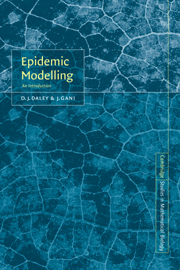1 - Some History
Published online by Cambridge University Press: 16 November 2009
Summary
The mathematical study of diseases and their dissemination is at most just over three centuries old. To give a full account of the history of the subject would require a book in itself. The interested reader may refer to Burnet and White (1972) for a natural history of diseases, to Fenner et al. (1988) for an account of smallpox and its eradication, and to Bailey (1975) and Anderson and May (1991) for an outline of the development of mathematical theories for the spread of epidemics. We shall be concerned with the more modest task of placing some of the recent epidemic models in perspective. We therefore present a selective account of historical highlights to illustrate the developments of the subject between the seventeenth and early twentieth centuries. Creighton (1894) gives a descriptive account of epidemics in Britain to the end of the nineteenth century, and Razzell (1977) for smallpox.
An empirical approach
The quantitative study of human diseases and deaths ensuing from them can be traced back to the book by John Graunt (b. 1620, d. 1674) Natural and Political Observations made upon the Bills of Mortality (1662). These Bills were weekly records of London parishes, listing the numbers and causes of deaths in the parishes. In his book, Graunt discussed various demographic problems of seventeenth century Britain. Four of his twelve chapters deal with the causes of death of individuals whose diseases were recorded in the Bills. These death records, kept irregularly from about 1592 onwards and continuously from 1603, provided the data on which Graunt based his observations.
Information
- Type
- Chapter
- Information
- Epidemic ModellingAn Introduction, pp. 1 - 19Publisher: Cambridge University PressPrint publication year: 1999
